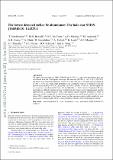The lowest detected stellar Fe abundance: the halo star SMSS J160540.18−144323.1
Author(s)
Nordlander, T; Bessell, M S; Da Costa, G S; Mackey, A D; Asplund, M; Casey, A R; Chiti, Anirudh; Ezzeddine, Rana; Frebel, Anna L.; Lind, K; Marino, A F; Murphy, S J; Norris, J E; Schmidt, B P; Yong, D; ... Show more Show less
DownloadSubmitted version (261.2Kb)
Open Access Policy
Open Access Policy
Creative Commons Attribution-Noncommercial-Share Alike
Terms of use
Metadata
Show full item recordAbstract
We report the discovery of SMSS J160540.18−144323.1, a new ultra metal-poor halo star discovered with the SkyMapper telescope. We measure Fe/H = -6.2 ± 0.2 (1D LTE), the lowest ever detected abundance of iron in a star. The star is strongly carbon-enhanced, C/Fe = 3.9 ± 0.2$, while other abundances are compatible with an α-enhanced solar-like pattern with Ca/Fe = 0.4 ± 0.2, Mg/Fe = 0.6 ± 0.2, Ti/Fe = 0.8 ± 0.2, and no significant s- or r-process enrichment, Sr/Fe < 0.2 and Ba/Fe < 1.0 (3σ limits). Population III stars exploding as fallback supernovae may explain both the strong carbon enhancement and the apparent lack of enhancement of odd-Z and neutron-capture element abundances. Grids of supernova models computed for metal-free progenitor stars yield good matches for stars of about 10M[subscript⨀] imparting a low kinetic energy on the supernova ejecta, while models for stars more massive than roughly 20M[subscript⨀] are incompatible with the observed abundance pattern.
Date issued
2019-07Department
Massachusetts Institute of Technology. Department of Physics; MIT Kavli Institute for Astrophysics and Space ResearchJournal
Monthly Notices of the Royal Astronomical Society: Letters
Publisher
Oxford University Press (OUP)
Citation
Nordlander, T. et al. "The lowest detected stellar Fe abundance: the halo star SMSS J160540.18−144323.1." Monthly Notices of the Royal Astronomical Society: Letters 488, 1 (July 2019): L109–L113 © 2019 The Author(s)
Version: Original manuscript
ISSN
1745-3925
1745-3933